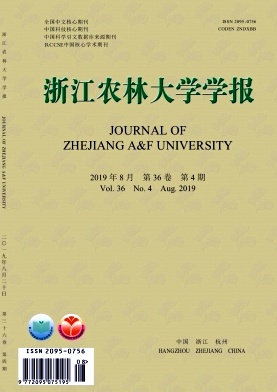-
印楝Azadirachta indica是世界著名农药植物[1-2]。印楝素(azadirachtin)因发现于印楝而得名,是目前世界上最优秀的天然产物农药。印楝素是印楝素A,B,D,E,F,G,H,I,K,L,M,N等一系列类似化合物的统称,其中印楝素A和印楝素B是主要成分。自然界中印楝素资源十分有限,来源仅限于印楝属Azadirachta植物,原产植物的生物合成仍是唯一的获得方式[3]。研究认为:印楝人工林种子印楝素性状表型变异丰富[4-6],研究和利用印楝品种印楝素质量分数的基因型(G)与环境(E)互作效应,进行品种印楝素质量分数稳定性和适应性育种,是提高品种印楝素生产力的重要途径之一。因此,开展印楝品种印楝素质量分数稳定性研究具有重要意义。生物体能自我调节其遗传型或表现型的状态以适应于变动的环境,使其生长发育和主要性状保持相对稳定的能力称为稳定性(stability)[7]。植物品种稳定性分析发端于多点试验基因型与环境互作效应(GE)的解析。所以,对基因型与环境互作效应的准确估计是合理评估植物品种稳定性的基础。品种稳定性分析有许多模型与方法。有学者认为不同稳定性分析模型适用于不同的试验数据,模型选择对品种稳定性评价有较大影响,并提出应在多种模型分析基础上的稳定性综合评估和可统一运用SAS中的PROC MIXED程序进行分析的分析策略[8-9]。印楝种源[4-5]、优树[10-12]、品比试验品种[13]种子印楝素组分稳定性已有研究,但多点试验品种种子印楝素组分稳定性研究末见报道。本研究以多点试验7个农药型印楝品种种子印楝素组分质量分数为分析数据,基于SAS PROC MIXED程序,比较5种常用品种稳定性分析模型在印楝品种种子印楝素组分稳定性分析中的分析效果,用Akaike信息量准则(cAIC)评价和选择最佳模型;根据稳定性类型的定义和稳定性形成机制的缓冲性学说推断稳定性类型和机制,保证印楝品种印楝素质量分数稳定性分析的有效性和科学性,丰富植物品种稳定性研究理论及实践,所获结果为农药型印楝品质育种提供理论依据。
HTML
-
试验数据取自本项目组开展的农药型印楝品种多点试验。试验地点为云南省元阳县、元江县和元谋县;试验品种为6个农药型印楝优良品种及平均木(ck):冷墩0505(Ld0505),阿土0515(At0515),乌湾0401(Ww0401),大黑公0507(Dhg0507),万星0423(Wx0423),万星0416(Wx0416)和平均木(ck)。通过优树选择[10-12]、品种品比试验[13]选出;试验采用随机完全区组设计,7个品种为1小区,3重复(区组),多系授粉,株行距为4 m × 4 m。样地管理、样株抚育基本一致,种子样品的采收、调制、保存和印楝素组分质量分数测定分析由专人完成。种子印楝素A和印楝素B质量分数用宗乾收等[14]的方法分析,印楝素AB的计算式:印楝素AB=印楝素A+印楝素B。
种子印楝素A、印楝素B和印楝素AB质量分数数据首先用Exce1 2007软件进行描述统计和隶属函数法转换[11];转换后数值再整理成一个品种-地点两向表,以变量T,G和E分别代表印楝素A或印楝素B或印楝素AB,品种和环境。其中每一个数值是相应品种在相应试验点内各重复的平均值。印楝素A,印楝素B,印楝素AB的品种-地点两向表分别以wdxazA,wdxazB,wdxazAB文件名存入SAS逻辑库的sasuser。
-
Stability Variance,Finlay-Wilkinson,Eberhart-Russell,AMNM-1和Environmental Variance等5种模型是最有代表性也最为常用的稳定性分析模型。由于供试数据为品种-环境组合处理均值(无重复数据),因此,本研究的5种稳定性分析模型与方法为处理均值的模型形式,5种稳定性分析模型的一般表达式,采用胡希远等[9]的处理均值模型形式。
-
上述模型统一运用SAS软件的PROC MIXED程序模块进行分析。具有UN(1),FA1(1),FA(1),FA1(1),UN方差协方差结构的线性混合模型依次等价于Stability Variance,Finlay-Wilkinson,Eberhart-Russell,AMMI-1,Environmental Variance模型[15],固定效应方差参数采用限制性极大似然法(REML)估计,效应差异显著性t测验的自由度采用Satterthwaite法估算,即利用PROC MIXED进行数据分析时,在MODEL语句中增加“ddfm=Satterthwaite”。基于处理均值数据的各稳定性模型分析的SAS程序如表 1所示。
模型 语句* 5种模型 proc mixed data=sasuser.wdxazA或sasuser.wdxazB或sasuser.wdxazABscoring= 20; class G E;model T=G/ddfm= satterthwaite; 模型 语句 Stability Variance模型 random int/ sub= E;repeated G/ sub= E type= un(1);run; Finlay-Wilkinson模型 repeated G/ sub= E type= FA1(1);run; Eberhart-Russell模型 repeated G/ sub= E type= FA(1); run; AMMI-1模型 random int/ sub= E; repeated G/ sub= E type= FA1 (1); run; Environmental Variance模型 repeated G/ sub= E type= un; run; 说明:*本行所列语句应出现在其他语句之前 Table 1. Syntax for the SAS commands to fit 5 stability analysis models for cultivar-environment treatment mean data
-
上述各种模型采用REML拟合时,以似然值的信息量准则评价和选择最佳模型,如Akaike信息量准则(Akaike’s information criterion,cAIC)[9]:
式(1)中:lnL为模型拟合极大似然值的自然对数值;q为模型中待估计方差协方差参数的数目。式(1)中右边第1项可解释为衡量模型对试验数据拟合优良度的一个度量,第2项可解释为对增加模型参数个数的一种平衡。当有若干个模型可供应用时,数据拟合效果好,而又尽可能节省参数数目的模型,即cAIC值最小的模型为最佳模型。在利用SAS中的PROC MIXED程序进行分析时,cAIC值将由该程序自动给出。
按照刘录祥等[16]的稳定性类型的定义界定印楝品种种子印楝素组分质量分数稳定性类型,根据ALIARD等[7]的缓冲性学说,结合当前最新研究成果,解释印楝品种种子印楝素组分质量分数稳定性形成机制。
1.1. 试验数据及其转换
1.2. 稳定性分析模型与方法
1.3. 稳定性模型分析的程序
1.4. 模型评价与选择
-
表 2为7个品种-环境组合处理均值的描述统计结果。方差、标准误是比较理想的描述数据变异程度的特征值,也是常用的以品种平均数为参照数的稳定性参数。从方差、标准误可以看出,在试验环境范围内7个印楝品种种子印楝素主要组分质量分数的变异幅度或稳定性不同。
试验 印楝素A/(mg·g-1) 环境指数 环境指数离差 Ww0401 Dhg0507 Wx0416 Wx0423 Ld0505 At0515 ck 元阳 6.5 6.5 5.5 6.3 8.6 7.1 4.5 -5.25 0.01 元江 7.0 6.6 5.9 6.4 7.8 7.3 5.0 -5.24 0 元谋 7.1 7.0 5.5 6.0 8.2 7.8 4.9 -5.23 -0.01 平均值 6.9 6.7 5.6 6.2 8.2 7.4 4.8 -5.24 - 方差 0.001 0 0.000 7 0.000 5 0.000 4 0.001 6 0.001 3 0.000 7 - - 标准误/% 3.21 2.65 2.31 2.08 4.00 3.61 2.65 - - 平均标准误比数ai 1.10 0.90 0.79 0.71 1.37 1.23 0.90 - - 试验 印楝素B/(mg·g-1) 环境指数 环境指数离差 Ww0401 Dhg0507 Wx0416 Wx0423 Ld0505 At0515 ck 元阳 2.2 1.4 1.0 1.1 2.4 2.1 0.9 -1.19 -0.01 元江 1.8 1.4 0.9 1.0 2.5 2.4 0.9 -1.19 -0.01 元谋 1.4 1.3 1.0 1.0 2.3 1.6 0.9 -1.21 0.01 平均值 1.8 1.4 1.0 1.0 2.4 2.0 0.9 -1.20 - 方差 0.001 6 0 0 0 0.000 1 0.001 6 0 - - 标准误/% 4.00 0.58 0.58 0.58 1.00 4.04 0 - - 平均标准误比数ai 2.60 0.38 0.38 0.38 0.65 2.63 0 - - 试验 印楝素AB/(mg·g-1) 环境指数 环境指数离差 Ww0401 Dhg0507 Wx0416 Wx0423 Ld0505 At0515 ck 元阳 8.7 7.9 6.5 7.4 11.0 9.2 5.3 -6.43 0 元江 8.8 8.0 6.8 7.4 10.3 9.7 5.7 -6.42 0.01 元谋 8.5 8.3 6.5 7.0 10.5 9.4 5.8 -6.43 0 平均值 8.7 8.1 6.6 7.3 10.6 9.4 5.6 -6.43 - 方差 0.000 2 0.000 4 0.000 3 0.000 5 0.001 3 0.000 6 0.000 7 - - 标准误/% 1.53 2.08 1.73 2.31 3.61 2.52 2.65 - - 平均标准误比数ai 0.65 0.89 0.74 0.98 1.54 1.07 1.13 - - 说明:-表示该项不存在 Table 2. Description statistics of cultivar-environment combination process
标准误与平均标准误比数(ai)也是常用的以品种平均数为参照数的稳定性参数。根据表 2各印楝品种种子印楝素组分质量分数的ai大小,可进行印楝品种印楝素质量分数稳定性大小的初步排序。
印楝素A:Wx0423(0.71)>Wx0416(0.79)>Dhg0507(0.90)=ck(0.90)>Ww0401(1.10)>At0515(1.23)>Ld0505(1.37)。
印楝素B:ck(0.00)>Dhg0507(0.38)=Wx0416(0.38)=Wx0423(0.38)>Ld0505(0.65)>Ww0401(2.60)>At0515(2.63)。
印楝素AB:Ww0401(0.65)>Wx0416(0.74)>Dhg0507(0.89)>Wx0423(0.98)>At0515(1.07)>ck(1.13)>Ld0505(1.54)。
从7个品种种子印楝素组分质量分数的方差、标准误、标准误与平均标准误比数所呈现的稳定性大小综合看:Ld0505,At0515,Ww0401印楝素A和印楝素B质量分数的稳定性较低;而Dhg0507,Wx0423,Wx0416,ck印楝素A和印楝素B质量分数的稳定性较高。
-
表 3是5种模型对印楝品种印楝素组分稳定性参数的估计结果。结果表明:5种模型在品种印楝素组分稳定性评判上表现出既相似又有差异的稳定性参数估计性能,表现为Finlay-Wilkinson和AMMI-1模型均能完成印楝素A,印楝素B和印楝素AB的稳定性参数估计,Eberhart-Russell模型只能完成印楝素A和印楝素AB的稳定性参数估计,Stability Variance模型仅能完成印楝素A的稳定性参数估计,而Environmental Variance模型不能完成印楝素A,印楝素B和印楝素AB的稳定性参数估计;Finlay-Wilkinson和AMMI-1模型不仅能完成品种印楝素A,印楝素B和印楝素AB的稳定性参数估计,且稳定性参数估计结果基本一致(稳定性参数大小基本相同)。7个印楝品种种子印楝素质量分数稳定性大小的排序如下。
试验 模型 不同品种稳定性参数 Ww0401 Dhg0507 W>0416 W>0423 Ld0505 At0515 ck Stability Variance 0.000 77 0.003 05 0.003 15 0.007 43 0.023 03 0.004 24 0.000 28 Finlay-W ilkinson 0.074 64 0.045 58 0.021 00 -0.018 95 -0.074 26 0.066 96 0.058 51 印楝素A Eberhart - Russell 0.073 75 0.032 27 0.036 87 -0.004 61 -0.092 19 0.050 70 0.064 53 AMMI-1 0.074 64 0.045 58 0.021 00 -0.018 95 -0.074 26 0.066 96 0.058 51 Environmental Variance - - - - - - - Stability Variance - - - - - - - Finlay-Wilkinson 0.216 90 0.035 28 -0.016 34 0.018 94 0.051 62 0.225 40 -2.19E-8 印楝素B Eberhart-Russell - - - - - - - AMMI-1 0.216 90 0.035 27 -0.016 34 0.018 94 0.051 61 0.225 40 -5.64E-6 Environmental Variance - - - - - - - Stability Variance - - - - - - - Finlay-Wilkinson 1.29E-19 0.016 00 0.019 02 -0.012 87 -0.060 47 0.038 14 0.041 45 印楝素AB Eberhart-Russell 0.020 26 -0.005 06 0.030 39 0.020 26 -0.045 58 0.040 52 0.015 19 AMMI-1 4.4E-20 0.016 00 0.019 02 -0.012 87 -0.060 47 0.038 14 0.041 45 Environmental Variance - - - - - - - 说明:-表示该项不存在 Table 3. Parameter estimates of cultivar variability for different analysis models
印楝素A:Wx0423(|-0.018 95|)>Wx0416(0.021 00)>Dhg0507(0.045 58)>ck(0.058 51)>At0515(0.066 96)>Ld0505(|-0.074 26|)>Ww0401(0.074 64)。
印楝素B:ck(|-2.19E-8|)>Wx0416(|-0.016 34|)>Wx0423(0.018 94)>Dhg0507(0.035 28)>Ld0505(0.051 62)>Ww0401(0.216 90)>At0515(0.225 40)。
印楝素AB:Ww0401(1.29E-19)>Wx0423(|-0.012 87|)>Dhg0507(0.016 00)>Wx0416(0.019 02)>At0515(0.038 14)>ck(0.041 45)>Ld0505(|-0.060 47|)。
Finlay-Wilkinson和AMMI-1模型的品种印楝素A和印楝素B质量分数的稳定性参数大小排序基本一致,Dhg0507,Wx0423,Wx0416,ck较Ld0505,At0515,Ww0401稳定;品种印楝素AB质量分数是印楝素A和印楝素B质量分数之和,其稳定性参数大小排序并没有表现出相应的排序。这些特性与方差、标准误、ai呈现的稳定性特性基本一致。
-
表 4是5种模型得到的印楝品种效应(均值)的差异性检验结果。5种模型在印楝品种种子印楝素组分的差异性检验上有既相似又有差异的差异性检验性能。表现为Finlay-Wilkinson和AMMI-1模型均能完成品种印楝素A,印楝素B和印楝素AB的差异性检验检验,Eberhart-Russell模型只能完成品种印楝素A和印楝素AB的差异性检验检验,Stability Variance模型仅能完成品种印楝素A的差异性检验检验,而Environmental Variance模型不能完成品种印楝素A,印楝素B和印楝素AB的差异性检验检验;Finlay-Wilkinson和AMMI-1模型不仅能完成品种印楝素A,印楝素B和印楝素AB的差异性检验,且差异性检验结果基本一致(F值基本相同),品种印楝素A和印楝素AB的差异达极显著水平(P<0.01),品种印楝素B的差异达显著水平(0.05>P>0.01)。表明Finlay-Wilkinson和AMMI-1模型对印楝品种种子印楝素质量分数参数的估计结果是科学的,7个印楝品种种子印楝素质量分数差异性真实存在。
试验 NDF 模型 Stability Variance Finlay-Wilkinson Eberhart-Russell AMMI-1 Environmental Variance DDF F P DDF F P DDF F P DDF F P DDF F P 印楝素A 6 10.2 172.90 < 0.000 1 2.55 85.77 0.004 3 2.01 273.91 0.003 6 2.55 85.77 0.004 3 - - - 印楝素B 6 - - - 2.18 55.59 0.013 3 - - - 2.18 55.59 0.013 3 - - - 印楝素AB 6 - - - 2.20 275.19 0.002 2 2.36 706.66 0.000 5 2.20 275.19 0.002 2 - - - 说明:NDF(Num DF)和DDF(Den DF)分别为F检验的第1自由度和第2自由度。-表示该项不存在 Table 4. F test of cultivar based on different analysis models
-
5种模型固定效应方差参数采用REML拟合,依据极大似然理论的信息量准则(cAIC)进行最佳模型的评价与选择。表 5为5种模型拟合得到的cAIC值。结果表明:5种模型在印楝品种印楝素组分固定效应方差参数拟合效果上有既相似又有差异的拟合性能。表现为Finlay-Wilkinson和AMMI-1模型的品种印楝素A,印楝素B和印楝素AB稳定性参数寻优均能收敛,Stability Variance模型的品种印楝素B和印楝素AB参数寻优不能收敛,Eberhart-Russell模型的品种印楝素B参数寻优不能收敛,而Environmental Variance模型的品种印楝素A,印楝素B和印楝素AB参数寻优均不能收敛。Finlay-Wilkinson和AMMI-1模型的品种印楝素A,印楝素B和印楝素AB稳定性参数寻优不仅均能收敛,且拟合结果基本一致(cAIC值基本相同)和拟合效果表现最佳(cAIC值均较小),具有较好的统计性能,而其余3种模型部分或全部印楝素组分统计表现不佳(cAIC值均较大),部分或全部未表现出统计性能。
试验 模型 Stability variance Finlay-Wilkinson Eberhart- Russell AMMI-1 Environmental variance 印楝素A -12.5 -17.3 -12.5 -17.3 - 印楝素B - -5.8 - -5.8 - 印楝素AB - -34.4 -17.3 -34.4 - 说明:-表示参数寻优未达到收敛 Table 5. cAIC values of different stability models (smaller cAIC value indicates better fitting models)
-
从7个品种印楝素组分稳定性的差异性检验结果(表 4)看,品种印楝素A,印楝素B和印楝素AB稳定性的差异性达显著水平,表明品种印楝素A,印楝素B和印楝素AB的稳定性随环境条件的变化会发生可预测的改变。按照刘录祥等[16]的稳定性类型的定义,品种印楝素组分质量分数稳定性均属于动态稳定性。进一步从7个品种不同环境的印楝素组分质量分数与相应的环境指数(表 2)看,Wx0416,Wx0423,Ld0505,ck的印楝素A和印楝素B质量分数与相应的环境指数并没有平行一致性(质量分数高低不随环境指数大小的变化而变化),动态稳定性差;而Ww0401,Dhg0507,At0515的印楝素A和印楝素B质量分数与相应的环境指数具有平行一致性(质量分数高低随环境指数大小的变化而变化),动态稳定性好。
7个品种是纯合的基因型或遗传上同质的群体,根据ALIARD等[7]的稳定性形成机制缓冲性学说,各品种印楝素A,印楝素B和印楝素AB的稳定性绝大部分依赖于个体缓冲性,也就是说品种各株系本身包括复杂的不同遗传型,每个遗传型能适应不同范围的环境条件,即具备个体缓冲性。这可能与印楝的异花授粉特性有关。
2.1. 品种-环境组合处理均值的描述统计
2.2. 不同稳定性分析模型对印楝品种印楝素质量分数的稳定性评判
2.3. 不同稳定性分析模型对印楝品种效应的差异性检验
2.4. 不同稳定性分析模型的拟合效果
2.5. 品种稳定性的类型及其形成机制
-
基于SAS PROC MIXED程序的品种稳定性分析策略与方法,具体是运用SAS软件PROC MIXED程序的5种常用品种稳定性分析模型模块进行品种稳定性参数估计、品种效应差异检验和模型评价与选择。本研究试验范围地处热带和亚热带干热河谷,7个参试品种在热带—亚热带气候和多系授粉的条件下,品种印楝素组分质量分数的稳定性随环境条件的变化会发生可预测的改变。印楝素A的稳定性排序为Wx0423>Wx0416>Dhg0507>ck>At0515>Ld0505>Ww0401,印楝素B的稳定性排序为ck>Wx0416>Wx0423>Dhg0507>Ld0505>Ww0401>At0515;印楝素AB质量分数是印楝素A和印楝素B质量分数之和,但其稳定性排序并没有表现出相应的排序,这可能因其是复合性状(由若干构成性状经代数运算得到性状值的性状)的缘故,因为复合性状的遗传效应比构成性性状(单独测量得到性状值的性状)更复杂。研究还表明:Wx0416,Wx0423,Ld0505,ck的印楝素A和印楝素B质量分数高低不随环境指数大小的变化而变化,动态稳定性差;而Ww0401,Dhg0507,At0515的印楝素A和印楝素B质量分数高低随环境指数大小的变化而变化,动态稳定性好。
-
5种模型统一运用SAS软件的PROC MIXED程序模块进行分析时,以似然值的信息量准则(cAIC)评价和选择最佳模型。cAIC值是衡量模型对试验数据拟合优良度的一个度量和对增加模型参数个数的一种平衡。cAIC值最小表示数据拟合效果好,而又尽可能节省参数数目,该模型为最佳模型。5种稳定性分析模型在印楝品种印楝素组分稳定性分析中的分析性能既相似又有差异,表现为Finlay-Wilkinson和AMMI-1模型的稳定性参数大小、差异性检验F值基本相同和稳定性参数寻优均能收敛,Akaike信息量准则基本一致(cAIC值基本相同、且均较小);而Stability Variance,Eberhart-Russell,Environmental Variance模型的稳定性参数大小、差异性检验F值各不相同和稳定性参数寻优部分或全部不能收敛,Akaike信息量准则不一致(cAIC值各异、且均较大)。Finlay-Wilkinson和AMMI-1模型适于印楝品种种子印楝素质量分数稳定性分析,其余模型则不适用。
需要说明的是,Finlay-Wilkinson和AMMI-1具有相似稳定性评判结果,这可能是两者虽然形式不同(有无环境主效应uj分析项),但实际地点间环境主效应uj差异不显著所致。而Finlay-Wilkinson和Eberhart-Russell虽然形式相同,但dij和fij假设不同,导致稳定性参数估计性能不同。Environmental Variance模型由于待估参数较多,在数据较少或品种数多于试验环境数时难以取得模型估计值[9]。Stability Variance模型由于它是从基因型与环境互作效应入手估算品种稳定性参数,仅表示了互作大小,没有反映出基因型随环境变化的反应方式;由于不同品种可能处在不同的基因型值水平,其稳定性参数间难以直接比较,结果也不如回归法精确[17-18]。另外,AMMI-1模型是品种稳定性非线性方法的代表,是一个模型系列,本研究只对具有一项乘积项的AMMI模型即AMMI-1模型进行了比较分析,其他AMMI模型分析的效果尚需进一步研究。
还需特别指出的是,上述基于SAS软件中PROC MIXED程序的5种稳定性分析都是基于传统的固定效应模型,采用品种-环境组合的处理均值数据(无重复数据)进行分析,是一种稳定性分析的简化方法[9]。基于SAS软件中PROC MIXED程序中的“ESTIMAT”语句,采用多点试验有重复观测值数据可进行随机效应模型(random-effects model)的区域试验品种评价,对随机效应采用最佳线性无偏预测(BLUP),准确地说是经验性最佳线性无偏预测(eBLUP),随机效应方差参数采用限制性极大似然法(REML)估计,能够利用方差参数提供的信息减小试验误差对效应排序的影响,从而使效应排序比利用BLUE的效应排序更准确。因此,近年来不断有学者建议在作物品种试验分析中将品种、环境和品种-环境互作效应三者之一或全部看作随机效应,并采用线性混合模型BLUP进行评价[19]。为了使印楝素质量分数的稳定性分析更加科学,尚需开展经验性最佳线性无偏预测(eBLUP)。
-
刘录祥等[16]认为:品种稳定性分为动态稳定性和静态稳定性。按照稳定性类型划分标准,本研究7个品种印楝素A,印楝素B和印楝素AB质量分数均值的差异性达显著水平,表明品种印楝素A,印楝素B和印楝素AB的稳定性随环境条件的变化会发生可预测的改变即动态稳定性。
就品种稳定性形成机制,许多研究者从遗传学、形态生理学和物候学等方面进行过探讨,创立了缓冲性学说[7]和因子补偿学说[16]。比较而言,缓冲性学说基于品种个体基因型和群体遗传组成;而因子补偿学说则不考虑品种本身的遗传组成,只基于影响性状的主要构成因子。它们各自反映了品种稳定性的不同侧面,2种解释都成立。本研究各品种均为无性系,是纯合的基因型或遗传上同质的群体,各品种间印楝素A,印楝素B和印楝素AB的稳定性绝大部分依赖于个体缓冲性。也就是说品种各株系本身包括复杂的不同遗传型,每个遗传型能适应不同范围的环境条件,即具备个体缓冲性。这可能与印楝的异花授粉特性有关。自然授粉状态下印楝异交率高于90%,而无性系多系杂交后各无性系间种子印楝素组分质量分数具有异质性(P<0.01)[13]。印楝素主要储存在印楝种子胚乳(endosperm)中[20],属于子代组织部分,隶属于胚乳,是胚乳性状,其遗传表达除受子代胚乳基因型(三倍体)控制外,还可能受子代胚基因型(二倍体)或母体基因型(二倍体)控制,或兼而有之及上位性、环境互作,遗传特性独特。按现代遗传学和表观遗传学观点,遗传物质改变即基因组变异(polymorphism)和表观遗传变异(epigenetic variation)决定着植物的表型。小于50个碱基对(base pair,bp)的变异,包括单核苷酸变异(single nucleotide variant,SNV)和小插入缺失(small indel);大于50 bp的基因组变异称为结构变异(structural variant,SV),包括缺失(deletion),插入(insertion),倒位(invsersion),易位(translocation)以及更复杂的结构变化;大段的基因组拷贝数变异(copy number variation,CNV)也可以视为结构变异的一种,即非平衡性结构变异(unbalanced SV),与之对应的是倒位、易位引起的不改变基因片段在全基因组拷贝数的平衡性结构变异(balanced SV)等基因组变异决定着植物的表型[21]。组蛋白修饰、DNA甲基化和miRNA等表观遗传变异也决定着植物的表型[22]。以此推测,印楝品种印楝素质量分数稳定性的遗传机制可能受遗传控制,包括基因和表观遗传调控机制。印楝基因组测序已完成,但印楝素的生物合成途径至今仍未完全解析[20, 23-25],控制印楝素合成和积累的关键基因或QTL仍未知。印楝品种印楝素质量分数稳定性的遗传机制尚需进一步研究。
稳定性作为高生产力水平下植物育种所追求的重要目标,是植物遗传育种工作者十分关心的问题。由于基因型与环境互作效应的存在,减少了同一基因型在不同环境条件下一致表现,从而使得基因型与表现型的相关性降低,在遗传育种试验中,降低了从表现型试验结果用以推断基因型的可信程度。开展植物育种工作,需要根据育种目标对基因型与环境互作效应加以仔细分析和充分利用。稳定性包括适应性和稳产性2个方面,对品种稳定性或适应性的评价主要依赖于稳定性参数的大小,而没有考虑品种平均产量高低的因素。实际上,当一个品种的平均产量相对于其他品种很高时,即使它的稳定性参数较大也是可以接受的,而只有当一个品种的产量较低时,它的稳定性才显得更重要。因此,在利用各种模型分析品种稳定性时,除了关注纯粹的稳定性参数大小外,还要结合各品种的平均产量等因素具体分析,才能对品种的稳定性或适应性做出更具实际意义的评价。如Ld0505和At0515的印楝素AB质量分数稳定性差,但其印楝素AB的产量较高,是推广良种的首选,分别在元阳和元江可获得更大收益。
3.1. 品种稳定性分析方法及分析结果
3.2. 品种稳定性分析方法的选择
3.3. 品种稳定性的类型及其形成机制
-
Finlay-Wilkinson和AMMI-1模型适于印楝品种种子印楝素质量分数稳定性分析,其余模型则不适用;Ww0401,Dhg0507,At0515的稳定性较Wx0416,Wx0423,Ld0505,ck好;印楝品种种子印楝素组分质量分数稳定性均为动态稳定性,稳定性绝大部分依赖于个体缓冲性。






 DownLoad:
DownLoad: